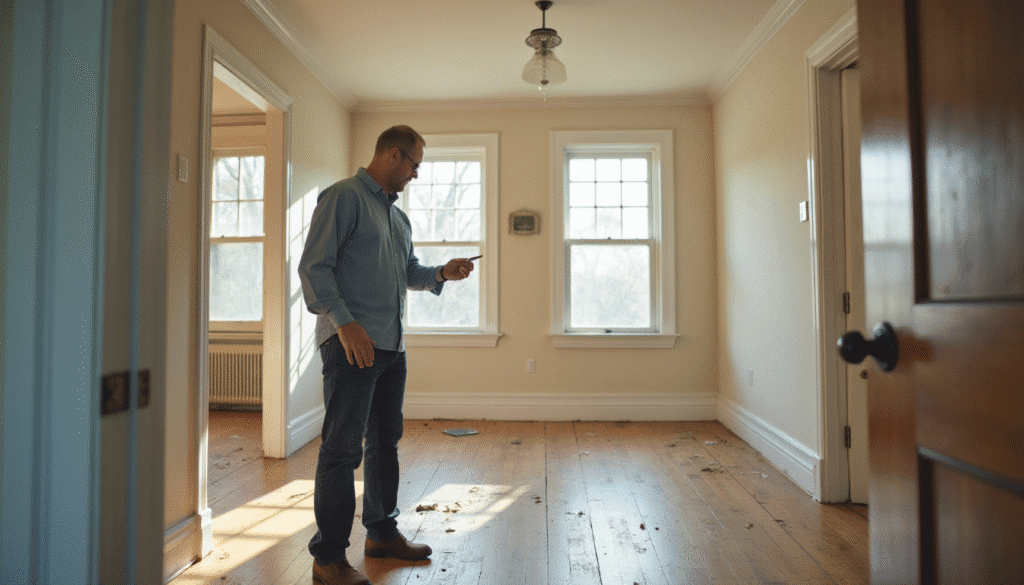Owning rental property in Garfield, NJ — or anywhere — comes with responsibilities that go beyond simply collecting rent. When a tenant’s behavior veers into hoarding, the stakes increase dramatically: safety, habitability, liability, and ethical considerations all come into play. This guide walks landlords through what hoarding really entails, why it matters, and how to handle it carefully, legally, and compassionately.
Understanding Hoarding: Not Just “Messiness”
Hoarding is more than a tendency to accumulate things — it’s a recognized mental health condition. With the publication of the American Psychiatric Association’s DSM 5 in 2013, Hoarding Disorder received formal acknowledgment as a mental disorder. :contentReference[oaicite:2]{index=2} This classification means that hoarding isn’t simply a behavioral quirk — for some, it’s a disability that affects their ability to discard or organize possessions, even when clutter creates serious safety or hygiene problems. :contentReference[oaicite:3]{index=3}
For a landlord, the difference is critical: a hoarding tenant isn’t just “messy” — they may be protected under disability and fair housing laws. At the same time, unchecked hoarding can create fire hazards, pest infestations, structural strain, blocked exits, mold, and other health or safety related risks. :contentReference[oaicite:4]{index=4}
Why Hoarding Matters for Landlords: Risks & Liabilities
Even if a tenant’s hoarding stems from a recognized disorder, landlords and property managers have duties to ensure that rental units remain safe, sanitary, and habitable. Excessive clutter can compromise those obligations in several ways:
- Fire hazards — piles of combustible items like boxes, paper, clothing, combined with blocked escape routes, can make a unit a fire trap. :contentReference[oaicite:5]{index=5}
- Pest infestations, mold, and poor sanitation — hoarding environments often attract vermin or insects, generate odors, trap moisture, or hide leaks, which may lead to mold or structural issues. :contentReference[oaicite:6]{index=6}
- Blocked exits or accessibility issues — clutter may obstruct hallways, doors, or emergency-exit routes; that’s a serious liability if emergency services are needed. :contentReference[oaicite:7]{index=7}
- Damage to property — excessive weight from hoarded items, neglect, and structural strain may result in costly repairs beyond standard wear and tear. :contentReference[oaicite:8]{index=8}
Ignoring hoarding issues can expose a landlord to damage costs, legal liability — especially if other tenants’ safety or quiet enjoyment is impacted — and violations of housing codes or safety regulations. :contentReference[oaicite:9]{index=9}
Before You Rent: Tenant Screening & Lease Preparation
Prevention is often easier than remediation. While you cannot reliably “predict” that a prospective tenant will hoard, a thorough screening process can help you identify red flags — for example, past references that cite cleanliness or maintenance issues. In addition, building a lease agreement with clear expectations around cleanliness, maintenance, and safety can help set the standard from day one. :contentReference[oaicite:10]{index=10}
One recommended tool is a “housekeeping addendum” or cleanliness clause to your lease. This addendum may specify requirements such as:
- Floors, walkways and doorways remain clear and free of debris or hazards
- Trash and garbage must be disposed properly and timely
- No accumulation of items that might attract pests or create fire or safety risks
- Common areas (if applicable) and entrance/exit routes must remain accessible and safe
- Kitchen, bathroom, appliances and utilities must be maintained in sanitary condition
These stipulations provide clarity from the outset — giving you legal leverage if conditions deteriorate, without directly targeting hoarding (which could raise fair housing or disability discrimination concerns). :contentReference[oaicite:11]{index=11}
Including a Cleanliness Clause: Lease Design That Protects Your Property and Respects Tenants
A carefully drafted lease — ideally paired with a housekeeping addendum — can set reasonable expectations while protecting both landlord and tenant rights. Given that hoarding qualifies as a disability under federal fair housing laws, a lease should focus on behavior (cleanliness, safety, habitability) rather than labeling or targeting hoarding or mental illness directly. :contentReference[oaicite:12]{index=12}
By focusing on objective, safety and health related requirements (e.g., “hallways and exits must remain clear”; “trash must be disposed promptly”; “unit must remain free of conditions that attract pests or block ventilation/exits”), you create a contract that is defensible and fair. That way, if issues develop, you can point to lease violations rather than a tenant’s mental health status — which helps mitigate risks under fair housing law. :contentReference[oaicite:13]{index=13}
Recognizing Early Warning Signs of Hoarding (Clutter, Odors, Pests, Exit Blockage)
Even with a strong lease, hoarding can sometimes creep in. That’s why building in routine inspections or walkthroughs — with proper notice — is key. As a landlord or property manager, keep an eye out for clues like:
- Accumulation of unused items, boxes, or trash in living spaces, hallways, or near exits
- Unusual odors, evidence of pests, or signs of neglect in sanitation or cleanliness
- Blocked exit routes, overcrowded rooms, or furniture/items placed in ways that obstruct movement
- Evidence of unsafe stacking or storage of flammable materials or objects
- Neglected maintenance issues (e.g. leaks, plumbing problems) that are hidden under clutter — which may lead to mold or water damage over time. :contentReference[oaicite:14]{index=14}
Document everything. Whenever you observe potential problems, take photos (with date stamps) or video — and log dates and notes. Clear documentation is invaluable if you later need to demonstrate lease violations, safety hazards, or justify corrective action. :contentReference[oaicite:15]{index=15}
How to Approach the Tenant: Communication with Compassion & Clarity
Because hoarding is often linked to mental illness, the way you approach the tenant matters. A confrontational or accusatory tone may trigger defensiveness or worsen the situation. As many experts recommend, start with concern for safety and clarity about lease obligations — not judgment. :contentReference[oaicite:16]{index=16}
For example, you might say something like: “I have some concerns about safety and access in your unit. I want to work with you to make sure the space is safe for you and the other residents.” Focus on specific risks (blocked exits, fire hazards, pests) rather than making generalized complaints about “clutter.” Provide a written follow up summarizing any conversation — including what was agreed, tasks to be done, and a realistic timeline. :contentReference[oaicite:17]{index=17}
This approach — combining compassion with clear expectations — often yields better results than demands or ultimatums. Also consider whether offering resources (cleanup help, mental health or organizing services) might enable better compliance. :contentReference[oaicite:18]{index=18}
Building a Plan: Cleanup, Timelines, and Reasonable Accommodations
Once the tenant agrees to address the issue, work with them to build a realistic, phased cleanup plan. Break tasks into manageable steps — for example: first clear exits and hallways, then empty trash, then address pest or mold issues, then reorganize storage, etc. Don’t expect an overnight transformation. :contentReference[oaicite:19]{index=19}
Set clear but reasonable deadlines for each phase, and schedule follow-up inspections to monitor progress. Document every inspection, noting what was done, what remains, and any patterns of non-compliance. Positive reinforcement (acknowledging improvements) can help — but maintain clarity that lease terms and safety standards must be met. :contentReference[oaicite:20]{index=20}
If the tenant genuinely struggles to declutter — perhaps due to the mental health disorder — consider reasonable accommodations under fair housing obligations: additional time, assistance with cleanup, even offering on site dumpsters or storage options if feasible. :contentReference[oaicite:21]{index=21}
At the same time, make clear that the goal is to restore safety and habitability. Excessive clutter that threatens safety — blocked exits, fire hazards, pest infestation, structural risk — cannot be ignored indefinitely. :contentReference[oaicite:22]{index=22}
When to Offer External Help: Cleaning Services & Mental Health Resources
Sometimes, a hoarder tenant may require more than reminders or lease enforcement — professional help can make all the difference. There are companies that specialize in hoarder cleanup, including removal of accumulated items, deep cleaning, and sanitation. ([landlordbuyers.com](https://www.landlordbuyers.com/blog/post/can-you-sell-a-property-when-the-tenant-has-been-hoarding?utm_source=chatgpt.com))
Additionally, many tenants may benefit from mental health resources. Hoarding disorder often responds well to cognitive behavioral therapy and professional support networks. Offering referrals to qualified mental health professionals or local hoarding support groups can help tenants comply with lease obligations while respecting their needs. ([ilercampbell.com](https://ilercampbell.com/blog/2023/10/hoarding-human-rights-obstacle-housing/?utm_source=chatgpt.com))
When engaging external help, document the process and keep records of cleanup efforts, timelines, and tenant cooperation. This documentation becomes vital if further enforcement, including eviction, becomes necessary. ([lifecycletransitions.com](https://lifecycletransitions.com/7-steps-to-handle-tenant-hoarding-situations-effectively/?utm_source=chatgpt.com))
When Hoarding Violates Lease / Safety Code — Grounds for Eviction
Even with compassionate handling and assistance, there are situations where hoarding threatens safety, health, or habitability to the extent that eviction may be necessary. In New Jersey, landlords must follow specific legal procedures when pursuing eviction, ensuring that the tenant’s rights are respected while addressing dangerous conditions. ([nutter.com](https://www.nutter.com/trending-newsroom-publications-Addressing-the-Challenge-of-a-Hoarding-Tenant-An-Advisory-for-Residential-Landlords-03-04-2013?utm_source=chatgpt.com))
Grounds for eviction in these cases typically focus on objective violations: blocked exits, fire hazards, unsanitary conditions, or pest infestations that breach the lease agreement or housing codes. Importantly, the eviction notice should cite specific violations rather than labeling the tenant as a “hoarder,” maintaining compliance with fair housing protections. ([kiplinger.com](https://www.kiplinger.com/real-estate/real-estate-investing/604848/what-to-do-when-your-tenant-is-a-hoarder?utm_source=chatgpt.com))
Step-by-step process includes:
- Document all observations, inspections, and communications
- Provide written notices specifying lease violations and remediation timelines
- Offer reasonable accommodation where appropriate, while emphasizing safety compliance
- Follow NJ landlord-tenant eviction procedures meticulously to avoid legal challenges
- Engage legal counsel if tenant disputes or fails to comply with the remediation plan
Eviction Process in NJ (and Considerations for Garfield NJ Landlords)
Eviction in New Jersey is a legal process that requires precise compliance with state law. Key considerations for Garfield landlords handling hoarder tenants include:
- Providing written notice to cure lease violations, typically 30 days
- Documenting repeated lease violations and unsafe conditions with photos and reports
- Filing a formal complaint in Landlord/Tenant Court if remediation fails
- Obtaining a court order for eviction before attempting removal
- Ensuring that all actions comply with Fair Housing laws to prevent claims of discrimination
Maintaining professionalism, patience, and clear documentation during this process not only protects your property but also demonstrates your adherence to the law if challenged in court. ([nutter.com](https://www.nutter.com/trending-newsroom-publications-Addressing-the-Challenge-of-a-Hoarding-Tenant-An-Advisory-for-Residential-Landlords-03-04-2013?utm_source=chatgpt.com))
Preventive Strategies for Future Tenancies
After managing a hoarder tenant, consider how to minimize risk in future tenancies. Preventive strategies include:
- Enhancing lease agreements with clear cleanliness and safety clauses
- Including routine inspections in the lease, with proper notice
- Screening tenants with thorough reference checks focusing on previous rental habits
- Educating tenants at move-in about safety, fire hazards, and maintenance responsibilities
- Keeping clear, documented communication channels to address early concerns promptly
By integrating these practices, landlords can protect their property, maintain safe living conditions, and reduce the likelihood of hoarding-related issues in the future. ([landlordtalking.com](https://www.landlordtalking.com/tips/tenant-screening/hoarding-tenants-place-rental-properties-at-risk/?utm_source=chatgpt.com))
Conclusion & Key Takeaways
Dealing with hoarder tenants in Garfield, NJ, requires a careful balance of legal knowledge, compassion, and proactive property management. Landlords must recognize the risks of hoarding, document conditions thoroughly, and employ clear lease agreements emphasizing safety and cleanliness. Early intervention, thoughtful communication, professional cleanup support, and legal awareness can help resolve issues while respecting tenants’ rights.
Preventive strategies — including rigorous tenant screening, lease addenda for housekeeping, and routine inspections — can reduce future risks and maintain the long-term value and safety of your property. By combining these approaches, landlords can effectively manage hoarder tenants while adhering to New Jersey’s landlord-tenant laws.
Disclaimer: This article is for informational purposes only and is not legal advice. Landlords should consult a qualified attorney for guidance regarding lease agreements, eviction procedures, or fair housing compliance.
For landlords facing hoarding challenges, acting early, documenting carefully, and prioritizing both safety and fair treatment of tenants is essential for successful property management in Garfield, NJ.






